Megan Is Missing: True Story? Gruesome Aspects & Realism
Have you ever watched a movie that lingered in your mind long after the credits rolled, blurring the line between fiction and reality? The chilling realism of 'Megan Is Missing' has sparked intense debate, leaving many to question if its harrowing portrayal of abduction and online predators is rooted in actual events.
Released in 2011, Michael Goi's "Megan Is Missing" is a found-footage psychological thriller that plunges viewers into the nightmarish ordeal of two teenage girls, Megan Stewart and Amy Herman, as they navigate the treacherous landscape of online interactions. Megan, lured by a boy she meets online, vanishes after agreeing to meet him in person. Amy, her best friend, spearheads the desperate search, only to disappear herself, leading to a terrifying descent into the dark underbelly of internet predation. The film, presented as a compilation of video chats, webcam footage, home videos, and simulated news reports, masterfully crafts an atmosphere of unsettling authenticity.
| Megan Is Missing: Fictional Film, Real-World Fears | |
|---|---|
| Title | Megan Is Missing |
| Genre | Found-footage, Psychological Thriller, Horror |
| Director | Michael Goi |
| Release Year | 2011 |
| Main Cast | Rachel Quinn (as Megan Stewart), Amber Perkins (as Amy Herman) |
| Plot Summary | Two teenage best friends, Megan and Amy, encounter the dangers of online predators, leading to their abduction and torment. The film is presented as found footage, creating a sense of realism and unease. |
| Inspiration | While not based on one specific case, the film draws inspiration from numerous real-life cases of child abduction and exploitation facilitated through online interactions. The kidnapping of Miranda Gaddis and Ashley Pond in 2002 has been cited as a potential influence. |
| True Story? | No, the film is a work of fiction. However, it aims to raise awareness about the dangers of online predators and the importance of internet safety. |
| Controversies | The film has been criticized for its graphic violence and exploitation of sensitive subject matter. It was banned in New Zealand due to its potentially harmful content. |
| Themes | Internet safety, online predators, child abduction, exploitation, the dangers of social media |
| Format | Found-footage, presented as a compilation of video chats, webcam recordings, and home videos. |
| Authentic Website | Megan Is Missing on IMDb |
The question that perpetually swirls around "Megan Is Missing" is whether it's based on a true story. The short answer is no. However, dismissing it as mere fiction is an oversimplification. While the specific narrative of Megan Stewart and Amy Herman is not a direct adaptation of any single real-life event, the film's creator, Michael Goi, drew inspiration from a chilling tapestry of actual cases involving young girls who fell prey to online predators. The "Megan Is Missing true story" Wikipedia page, while not validating the film's plot as a direct recounting of an incident, serves as a grim reminder of the numerous documented instances where vulnerable young individuals were abducted and murdered after connecting with strangers online.
- New South Movie Hindi Dubbed Download 2025 Your Ultimate Guide
- Lux Movies Bollywood Where Glamour Meets Entertainment
The persuasive power of "Megan Is Missing" lies in its verisimilitude. Despite the disclaimer that the footage is entirely fictional, the film intentionally blurs the boundaries between reality and fabrication. Goi's strategic use of the found footage format, coupled with the employment of inexperienced or relatively unknown actors, contributes significantly to the unsettling sense that what unfolds on screen is, or at least could be, real. The shaky camera work, the unpolished dialogue, and the raw emotional performances all coalesce to create an immersive experience that can leave viewers deeply disturbed and questioning the safety of the digital world.
The film's promotional materials further enhance this sense of realism. Marketing the film as "assembled from video chats, webcam footage, home videos, and news reports" fuels the perception that "Megan Is Missing" is more than just a work of fiction. This calculated ambiguity contributes to the film's notoriety and its enduring ability to spark debate about the extent to which it mirrors real-world dangers.
Consider the plot points: Megan initiates contact with a boy she encounters online, setting in motion a chain of events that culminates in her disappearance. Her best friend, Amy, driven by loyalty and concern, embarks on a determined quest to locate Megan. As the media spotlight intensifies around Megan's vanishing, Amy unearths the horrifying truth regarding her friend's fate. These narrative threads, while fictional in their specific configuration, resonate with countless documented cases of online grooming, abduction, and exploitation. Therefore, while viewers may be inclined to believe the events depicted in the film are ripped from the headlines, the reality is more nuanced: "Megan Is Missing" is not a direct dramatization of a particular true crime; rather, it is a composite narrative informed by a disturbing pattern of real-world tragedies.
- Why Vegamovies Is Your Ultimate Destination For Movie Enthusiasts
- Www Filmy4web Com 2024 Your Ultimate Guide To Streaming Movies Safely And Legally
The absence of concrete evidence linking "Megan Is Missing" to a single, verifiable true story is repeatedly emphasized. No, "Megan Is Missing" is not real. "'Megan Is Missing' is not based on a true story." This assertion underscores the understanding that the footage showcased in the film is entirely fabricated. Despite the attempts to emulate the visual language of authentic documentation, the film remains a work of fiction. The question, "Is 'Megan Is Missing' a true story about internet safety?" is best answered with a qualified response: while the film is not based on a specific true story, it undeniably serves as a stark cautionary tale about the paramount importance of online safety and the potential perils lurking within the digital realm.
The film’s director, Michael Goi, has stated explicitly that “'Megan Is Missing' is not based on a true event.” However, he has also acknowledged that the kidnapping of Miranda Gaddis and Ashley Pond in 2002 served as a source of inspiration. This admission sheds light on the film’s origins: it is not a direct retelling of a specific crime, but rather a fictionalized exploration of themes and scenarios drawn from real-world cases. The storyline, centering on Megan (portrayed by Rachel Quinn) and Amy (played by Amber Perkins), two young teenagers who experience abduction and torment after engaging with a stranger online, is a carefully constructed narrative designed to shock, disturb, and, ultimately, raise awareness.
The debate surrounding the film's verisimilitude extends to the very nature of found footage as a genre. Does the film contain real footage? The answer is unequivocally no. All of the footage is staged and acted. This fact, however, does little to diminish the film's impact. The deliberate use of amateurish cinematography, the incorporation of seemingly unscripted dialogue, and the overall sense of immediacy contribute to the illusion of authenticity. It is this calculated manipulation of cinematic techniques that allows "Megan Is Missing" to bypass viewers' rational defenses and tap into their deepest fears and anxieties.
The film’s explicit content and disturbing imagery have made it a lightning rod for controversy. "Why was 'Megan Is Missing' banned in New Zealand?" The answer lies in the film’s perceived potential to cause harm. Critics argued that the film's graphic depiction of violence and sexual exploitation could desensitize viewers to real-world abuse or even inspire copycat crimes. The ban in New Zealand highlights the ethical complexities surrounding the portrayal of sensitive subject matter in film and the responsibility of filmmakers to consider the potential impact of their work on audiences.
The film's enduring popularity, fueled in part by its resurgence on platforms like TikTok, has reignited the debate about its origins and its message. Viewers continue to grapple with the question of whether "Megan Is Missing" is based on a true story. The film's official stance remains consistent: it is a work of fiction. However, the inspiration drawn from real-life cases, the skillful use of found footage techniques, and the pervasive sense of unease that permeates the narrative all contribute to the impression that the film is more than just a fabrication. The question of whether "Megan Is Missing" is based on a true story remains a complex one, with no easy answer.
The narrative revolves around Megan and Amy, young teens who are kidnapped and tortured after communicating with a stranger they encountered on the internet. The film follows the investigation into the disappearance of Megan Stewart, and Amy’s subsequent pursuit of answers leads to her own vanishing. As the media frenzy surrounding Megan’s disappearance intensifies, Amy uncovers the horrifying truth about what befell her friend.
There have been numerous discussions on social media platforms concerning the veracity of the final 22 minutes of "Megan Is Missing," specifically whether they are based on true events or are entirely fictionalized. The prevailing consensus, supported by the filmmakers' statements, is that the last 22 minutes, while disturbing and graphic, are not based on specific documented events. The explicit content is intended to shock and provoke a response, but it is ultimately a product of creative license rather than a faithful representation of reality. These final moments, notorious for their intense and disturbing nature, solidify the film's reputation as a controversial and unforgettable viewing experience.
Ultimately, "Megan Is Missing" functions as a cautionary tale about the dangers of interacting with strangers online. While the specific events depicted in the film are not based on a true story, the underlying themes of online predation, abduction, and exploitation are very real and pose a significant threat to young people. The film serves as a stark reminder of the importance of internet safety, responsible online behavior, and the need for vigilance in protecting oneself and others from the potential dangers lurking in the digital world. The film’s exploration of these themes, regardless of its fictional status, makes it a relevant and thought-provoking work, sparking crucial conversations about online safety and the responsibility of parents, educators, and law enforcement to address the issue of internet predation.
In essence, "Megan Is Missing" capitalizes on the anxieties surrounding online interactions and the vulnerability of young people in the digital age. By presenting a fictional narrative in a realistic and unsettling manner, the film forces viewers to confront uncomfortable truths about the potential dangers lurking online. While it's crucial to remember that the events depicted are not real, the film's impact lies in its ability to raise awareness and spark dialogue about the urgent need for internet safety and the protection of children in the online world. The film, directed by Michael Goi, was released in 2011 and has since gained a cult following, particularly among those interested in true crime narratives. The film tells the story of two best friends, Amy and Megan, who engage with an online predator.
- Hindi Filmywap Your Ultimate Guide To Bollywood Movies And Entertainment
- Filmy Flyin Xyz Your Ultimate Movie Streaming Destination

Megan Is Missing Truth Behind The Story?

Is ‘Megan Is Missing’ Based On A True Story? Thought Catalog

Is Megan is Missing Based on a True Story? Everything You Need to Know